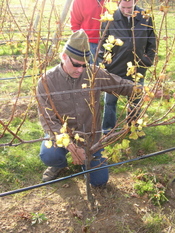 Long Island wine country might seem quiet right now. But it’s not.
Long Island wine country might seem quiet right now. But it’s not.
Visit the North Fork this time of year and (even without any snow) the landscape seems barren compared to any other time of the year. Most of the farm stands are closed, with the few that do stay open relying on greenhouse vegetables and crops like potatoes, carrots and apples.
The vineyards, alive with lush canopies, ripe clusters and harvest teams only a few short months ago, have fallen silent. It’s a quiet that you can feel when you visit the tasting rooms this time of year.
To the casual observer, this seems like the season when winemakers and vineyard managers can catch up on sleep sacrificed during harvest, but the vineyard never rests, not really. Downtime isn’t a part of a vineyard. There is always more to do.
As the father of an 11-month old, I can relate.
This is pruning season in wine country. And as you can read in Mark Harrington’s piece this week, it’s a time-consuming, labor-intensive process. Pruning isn’t a part of the winemaking process that is talked about very often, but it’s crucial to the health of the vines, the ripening of the fruit and the resulting quality of the finished wines.
This picture is one I snapped of David Page from Shinn Estate Vineyards a couple years ago when he was demonstrating pruning technique to a tour group. The process would be difficult enough if it were as simple as manual, time-eating labor, but it takes a great deal of knowledge and thought to prune too. I can’t imagine how any vineyard manager would put the vines in the hands of mechanical pruners. Not here on Long Island at least, where it’s so important to give the grapes the best chance to ripen.
So when you’re out in wine country over the next couple of months (and this is a great time to go), take a moment and think about the work that is still being done to bring you delicious wine.
